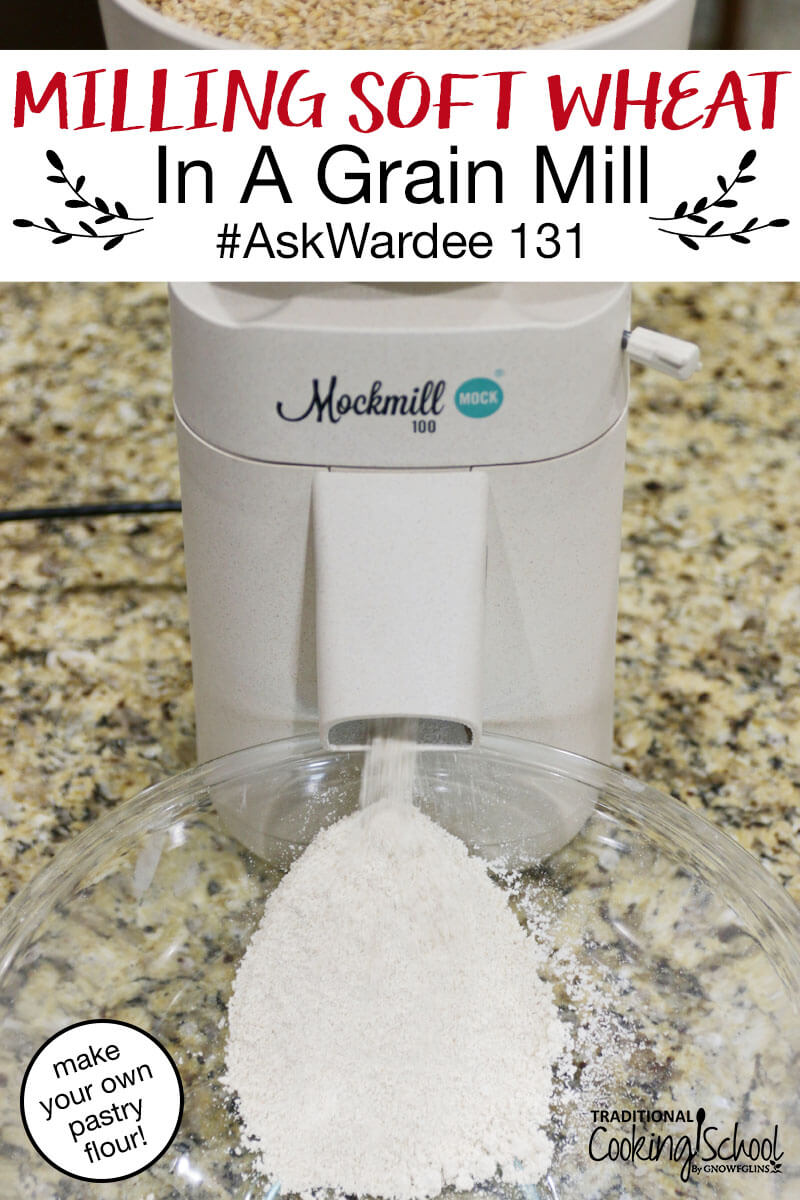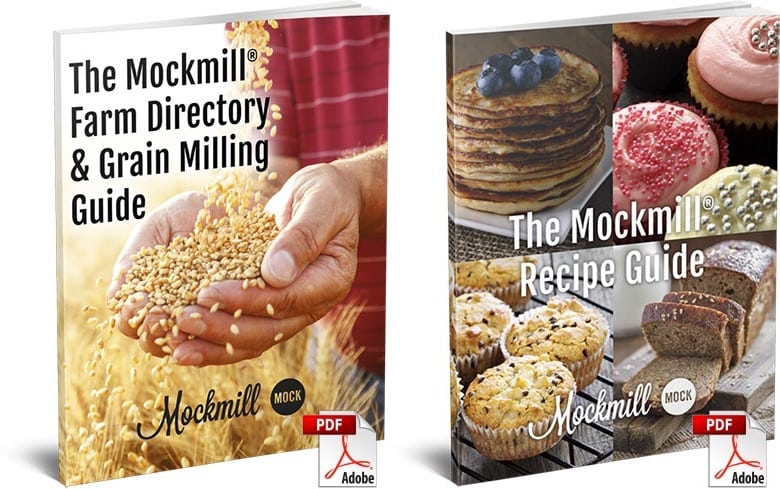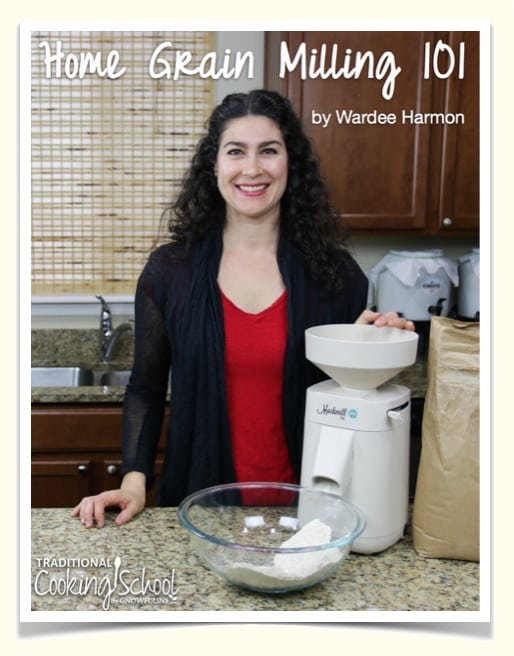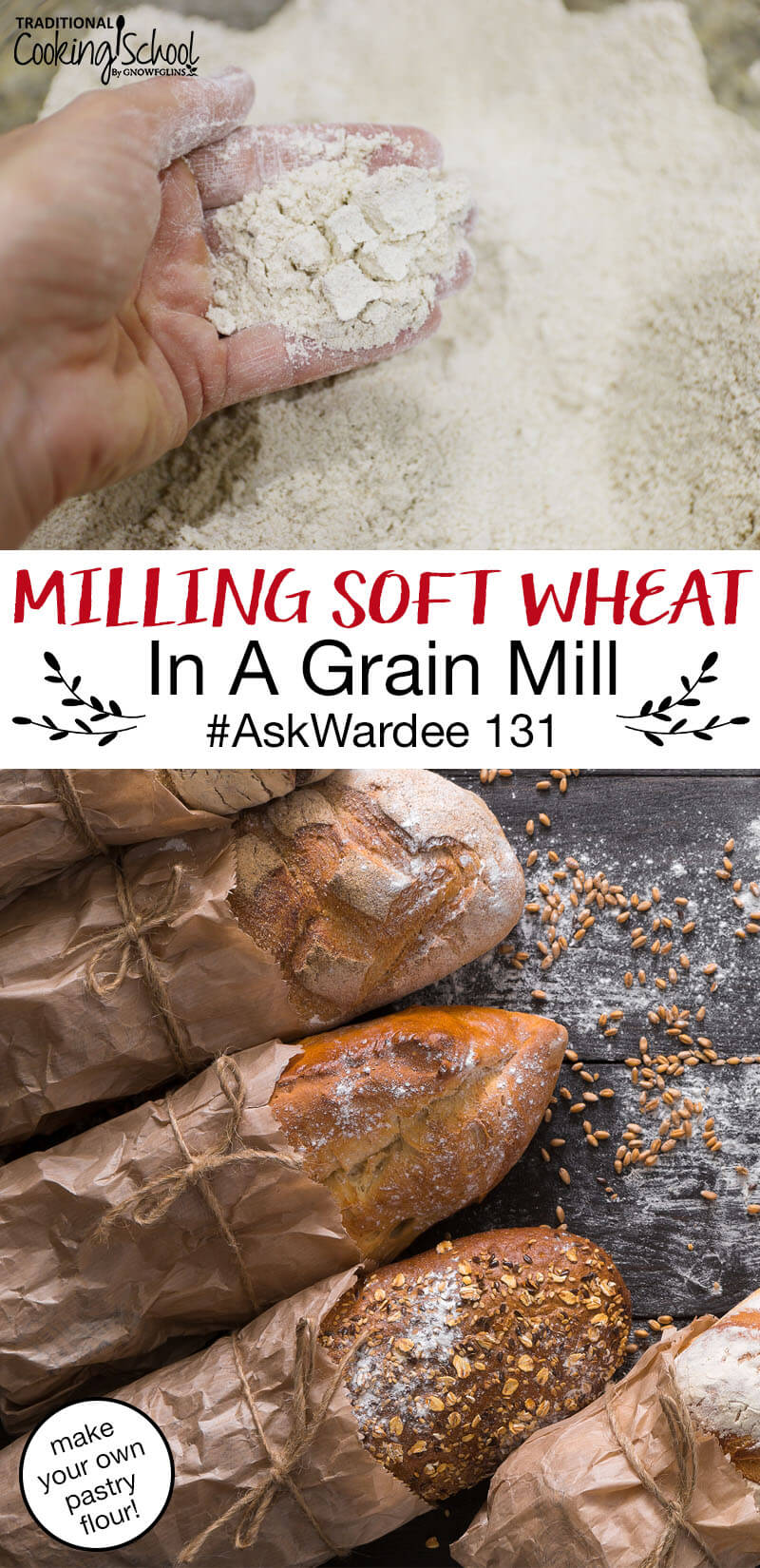
Want our FREE “Home Grain Milling 101” eBook? Click here to download the “Home Grain Milling 101” eBook for FREE!
Melisa G. says she’s been using soft red wheat flour for years and wants to know if she continues using that same grain, yet milling it herself in a home grain mill she’s soon to invest in.
Soft red wheat makes a wonderful homemade pastry flour and I’ll tell you what you need to know about milling it at home yourself in today’s #AskWardee.
Subscribe to #AskWardee on iTunes, Stitcher, YouTube, or the Podcasts app.
Table Of Contents
The Question: Can I Mill Soft Wheat At Home?
Melisa G. says:
Hi Wardee,
I’m a traditional Southern cook who is trying to incorporate more of your GNOWFGLINS methods into my daily recipes.
I have used a soft red winter wheat flour (White Lily, by brand) exclusively for over 30 years. I hope to purchase a home grain mill soon. Can I continue to use this type of wheat for home ground flour?
I know I can purchase the organic berries from azure standard and other companies but would love to know your ideas about this type of wheat.
Thank you,
Melisa G.
Melisa, thank you for your question!
Because we’re featuring your question today’s #AskWardee, you’re getting a gift — a FREE Mini eCourse! Our team will be in contact with you so you can choose which one you’d like!)
Melisa, I’m going to answer your simple question first and then go in a direction to fill in more blanks… perhaps questions you didn’t mention but want to know, too. 🙂
Can You Grind Soft Wheat Into Flour With A Grain Mill?
Absolutely! All grain mills can grind both soft and hard wheat of all varieties. To the mill, they are not different. As long as the berries are dry, they can be milled.
While I haven’t used your particular brand of soft wheat, Lily, I have used soft wheat pastry flour a lot over the years. It mills beautifully in all home grain mills.
And yes, in case you’re wondering, you can mill sprouted hard or soft wheat berries, too! As long as they are fully dried after sprouting, they can be milled just fine in any grain mill.
Here’s a more detailed explanation of how to grind your own flour, pastry or otherwise, how to store grains and how much flour to grind for your recipes.
What Is “Soft” Wheat?
You have two major types of whole wheat — soft and hard. Now there are many varieties among those, like soft red, soft white, hard red, hard white, and more.
Yet it’s important to know the difference between soft and hard so you can get the right results in your baking, especially when baking with fresh-ground flour.
Hard whole wheat has more gluten, making it heartier and more suitable for loaves of bread.
Soft whole wheat has less gluten, making it suitable for pastry-type foods like muffins, cookies, cakes, and flatbreads. Soft wheat often goes by the common name of “pastry flour” and you can tell why now, right?
And while you can use hard wheat in pastries, and they just end up more hearty, it doesn’t work so well the other way around. You can’t use soft wheat or pastry flour in loaves of bread, at least not if you expect good results. Soft wheat, lacking gluten, can’t develop a good bread structure.
One of the reasons our family has stopped using whole wheat in favor of ancient grains like spelt or einkorn is because the older grains are more versatile. I’ve found that the resulting flour is light for pastries (especially if sifted as I show here) and hearty for loaves of bread. And in addition to that, the ancient grains are arguably more healthy (gentler gluten and such).
I recommend, if using wheat, to use both hard and soft in your kitchen. That way, you’ll get the best results no matter what you’re baking!
My Favorite Grain Mill: The Mockmill — Save 5%!
The Mockmill is my favorite grain mill and the one I recommend! I’ve been recommending it for a while now and lots of you have already gotten one in your homes. Mockmill tells me you’re very happy and I’m glad about that. 🙂
The Mockmill is a home stone grain mill, and it’s engineered and manufactured in Germany by Wolfgang Mock. He started making home grain mills back in the 1970s, so he’s been doing it for over 40 years. It’s estimated that nearly 70% of the stone mills out there are made by him.
This mill is super exciting because it contains the best features of Wolfgang Mock’s milling career, yet it’s much more affordable. The reason it’s more affordable is because this mill comes in a durable recycled material housing (instead of expensive wood).
I love the Mockmill because it produces super healthy freshly-ground flour with a really fine texture. It doesn’t warm the flour up like some mills do, so the flour is more nutritious. Finally, the flour yields wonderful, light bread!
This mill will also grind all grains, even gluten-free. It can even crack grains for porridge, and it has many other uses (like some spices, nuts, and seeds).
See How The Mockmill Works In This Video…
All the details — including an exclusive 5% OFF and FREE SHIPPING — are on this page. By the way, it also comes as a KitchenAid attachment — very exciting for those who don’t want another appliance to take up any more room!
Also with your purchase of the Mockmill for 5% OFF, you’ll get two fantastic eBooks from the Mockmill team: The Mockmill Farm Directory & Grain Milling Guide and The Mockmill Recipe Guide. Both of these eBooks are fabulous!
And, for a limited time… if you decide to purchase the Mockmill, I’m ALSO throwing in complimentary copies of both my Sourdough A to Z and Einkorn Baking Mini eCourses. They’re each worth $64 for a total of $128 in additional bonuses from me.
To claim your extra free bonuses from me after purchasing the Mockmill at 5% OFF, just go to tradcookschool.com/millbonus. Have your order # handy, because you’ll need it to claim the two free eBook packages! (Your bonuses from Mockmill will come from them.)
 Want our FREE “Home Grain Milling 101” eBook? Click here to download the “Home Grain Milling 101” eBook for FREE!
Want our FREE “Home Grain Milling 101” eBook? Click here to download the “Home Grain Milling 101” eBook for FREE!
Any Questions Or Comments?
If you have other questions or comments about your own experience with milling soft wheat or other grains at home, be sure to leave them in the comments!
Helpful Links
- The Mockmill —my favorite and recommended (affordable) home stone grain mill — Hurry! Get 5% OFF and $128 in Mini eCourses from me for a limited time!
- Claim your FREE ($128 value) bonuses from me with your purchase of the Mockmill here!
- 8-cup hand-crank sifter
- Free “Home Grain Milling 101” eBook — our entire 4-part series combined into a single, FREE download from me!
- Home Grain Milling 101, Part 1: The Basics
- Home Grain Milling 101, Part 2: Milling Gluten-Free Grains Into Flour
- Home Grain Milling 101, Part 3: Baking With Fresh Ground Flour
- Home Grain Milling 101, Part 4: More Fun Things Your Grain Mill Can Do!
- Do Sprouting, Culturing, Or Sourdough Reduce Carbs? AW905
- FREE Webclass: Baking With Fresh-Ground Flour
- FREE No-Knead Sourdough Einkorn Bread Recipe
- FREE Sourdough Starter Instructions
- Why I <3 Einkorn — in case you want to know why we bake with the healthier 5,000 year-old wheat called einkorn!
- Where To Buy Einkorn
- Nutrimill
More Mockmill Related Articles from the #AskWardee Show:
- Unboxing The Mockmill (Affordable Home Stone Grain Mill)
- Differences Between Nutrimill And Mockmill #AskWardee 120
- How To Simply & Easily Clean Your Mockmill Grain Mill #AskWardee 119
- Where To Buy Whole Wheat Berries, Grains, and Flour #AskWardee 148
- How to Mill Flour at Home: Home Grain Milling 101
- Buckwheat Flour 101: Choosing, Milling Flour, Sprouting, Recipes & More! #AskWardee 141
- Is The New Ultragrain White Whole Wheat Healthy? #AskWardee 112
What Is The #AskWardee Show?
The #AskWardee Show is the live weekly show devoted to answering your niggling questions about Traditional Cooking: whether it’s your sourdough starter, your sauerkraut, preserving foods, broth, superfoods or anything else to do with Traditional Cooking or your GNOWFGLINS lifestyle.
I share tips and resources, plus answer your questions about Traditional Cooking!
The Details
When: Wednesdays at 10am Pacific / 1pm Eastern
Where: Traditional Cooking School on Facebook Live or @TradCookSchool on Instagram Live
What If You Can’t Make It?
Don’t worry. You can catch the replays or listen to the podcast!
- Come back here to AskWardee.TV; all replays will be up within hours of airing live; the print notes are always posted at the same time I go live.
- Go to Traditional Cooking School on Facebook to view the Facebook Live replay or go to @TradCookSchool on Instagram on your phone or tablet (Instagram recording only lasts 24 hours).
- Subscribe to the #AskWardee podcast on iTunes, Stitcher, YouTube, or the Podcasts app. While you’re there, be sure to leave a rating and review!
Want To Get YOUR Question Answered?
Here’s how to submit your question. If we answer it on #AskWardee, you’ll get a gift!
- Tweet your question to @TradCookSchool on Twitter; use hashtag #AskWardee
- Send an email to wardee at AskWardee dot tv — add #AskWardee to your email so I know it’s for the show
Please do NOT add future questions for #AskWardee to the comments of this post because they might get missed!
Do you use soft wheat berries for homemade pastry flour? Why or why not? Please share your experience in the comments!
...without giving up the foods you love or spending all day in the kitchen!

2 free books:
Eat God's Way
Ditch the Standard American Diet, get healthier & happier, and save money on groceries...
We only recommend products and services we wholeheartedly endorse. This post may contain special links through which we earn a small commission if you make a purchase (though your price is the same).





I have been milling my own grain for a year, but never milled soft white until yesterday. I ground it at moderate course setting, then sifted it, then milled the flour in a “fine” setting. I used it to make a cake and it was a disaster. the cake completely fell apart. I have used the same recipe with store-bought “cake four” and it has always turned out great. What did I do wrong?
Hi, Antoinette.
I’m sorry we don’t know what happened.
~Danielle, TCS Customer Success Team